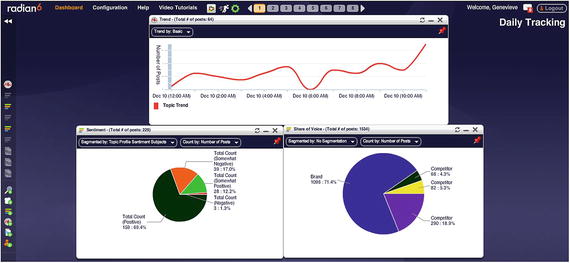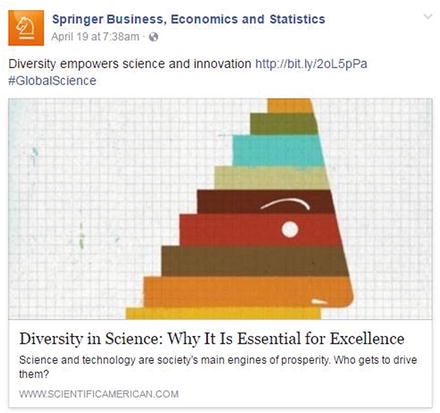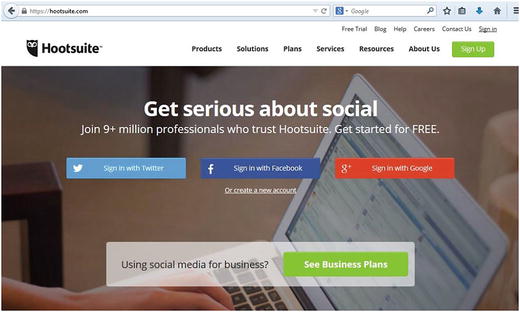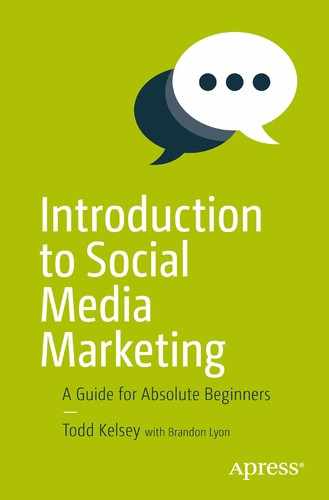This chapter covers the basics of social media. With any luck, you’ll have fun along the way as well!
Return on Investment (ROI)
ROI , or return on investment, is one of the themes following you around throughout this book.
But don’t be alarmed.
Actually, do be alarmed—not by the concept of ROI, but by the consequences of not measuring ROI.
In the context of social media marketing, it simply measures the financial return when a business, organization, or individual spends money on social media marketing.
This issue has gotten out of control in social media—there is a real lack of measuring the true impact. Social media came along, launched like a rocket, and suddenly every business had to have it in one form or another.
Businesses became mesmerized, helped along by the media hype, and encourage by agencies that suddenly had a new source of income.
In no time at all, everyone was marching in step.
The problem is that no one really knew how to measure ROI. So people got hired—agencies got hired—but then in some cases, both people and agencies got fired, as businesses and organizations started asking the question:
“Okay, but how is this impacting our revenue?”
Hype: “No, it’s cool man, social media is all about engagement.”
Business: “All right, what is engagement?”
Hype: “Oh, it’s really cool. You go out on social media, and it’s all about the customer. It’s like customer-centric man, you meet people in multiple touch points and engage. It’s awesome.”
Business: “Okay, so how does it make us money?”
Hype: “Yeah, the opportunities are tremendous! You just go out, and like make a Facebook page, and go on Twitter, and YouTube, and everywhere you can. And then you engage people with a positive brand experience.”
Business: “What’s a positive brand experience? Does that elevate purchase intent?”
Hype: “Totally man! Yeah, that’s it. It elevates purchase intent.”
Business: “Okay, cool. So how much revenue did we generate when we paid you to engage our audience and elevate their purchase intent?”
Hype: “Wow, man, that’s feeling kind of black and white. You need to look at the situation holistically. People are spending a lot of time on social media, so that’s where you need to be, man.”
Business: “I see. So people actually make purchases on social media?”
Hype: “Well, um . . . sometimes, I think. But wait, here’s this really interesting infographic that shows all the social networks people spend time on. Isn’t it great?”
Business: “I suppose. So what does ‘social influence’ mean?”
Hype: “Yeah, I almost forgot! It’s totally all about influence. Yeah, go out and identify the influencers. Make sure you have influence. It’s all about influence and the power of social referral.”
Business: “You mean word of mouth marketing?”
Hype: “Yeah, totally, word of mouth marketing. Like referring things you like to your peers. Bragging rights, show and tell, look what I’ve got, look what I found.”
Business: “Okay, so how does that translate into actually making money?”
Hype: “Well, some businesses are starting to make money . . .”
So you kind of get the picture.
The Skill of Social Media Marketing
The bottom line is that regardless of how closely people are tracking the return on investment of social media, it’s here to stay. And it’s also true that social media marketing, as a core skill in digital marketing, is a top skill that gets people hired.
According to LinkedIn , social media marketing was the hottest skill that got people hired in 2013 (See https://blog.linkedin.com/2013/12/18/the-25-hottest-skills-that-got-people-hired-in-2013 .)
Each year the way they refer to digital marketing seems to change, but since 2013, digital marketing (of which social media marketing is a core part) has been at the top. Demand will fluctuate over time, but we are talking about the top skills in any field to get people hired.
2014: https://blog.linkedin.com/2014/12/17/the-25-hottest-skills-that-got-people-hired-in-2014
2015: https://blog.linkedin.com/2016/01/12/the-25-skills-that-can-get-you-hired-in-2016
2016: https://blog.linkedin.com/2016/10/20/top-skills-2016-week-of-learning-linkedin
One of the other things I’ve seen in my career, which I try to reinforce in my books and in my classes, is the way that the core areas of digital marketing are related. For example, I consider social media marketing to be tightly connected to search engine optimization , or SEO. In SEO, a core goal to get higher search engine rankings is to develop and deploy content to your web site, which is relevant to your audience, relevant enough to share with other people. And where are people going to share it? On social media. And if you publish an article or blog post on your web site, where is a good place to share it? On social media.
So all I’m saying is, just like any other skill, social media marketing needs to contribute to a business or organization in a concrete way. So ROI is a really good idea to keep in mind—something to think about and learn about.
2B or not 2B? B2B and B2C
I tend to start drowning when I start swimming in acronyms, but with the right technique, you can use them well. If acronyms make you feel nauseous at all, now is the time to take some Dramamine.
If you haven’t heard already, B2B and B2C are two important acronyms in business, and they have a special implication for the type of social media you might work on.
B2C stands for business to consumer . So can be a retail business, such as Walmart , or Amazon , where the primary customer is an individual. You can think of B2C as a “shopper-oriented business.”
B2B, on the other hand, stands for business to business. This is one business selling products or services to another.
There are similarities in the way you market products to businesses and consumers, but there are also differences. In general, a business to business, B2B, approach has a longer sales cycle .
For example, if you worked at a software company and your job was to fill out TPS reports, you might suggest using an outside service to help fill out the reports. You might go online, do some research, and determine the costs. You could go to a TPS provider directly, but you could also hire an agency with expertise to advise you. So you might have meetings and submit your proposal internally. Your boss might say, “Great idea, looks like it costs a lot; let’s look at this next quarter.” In three months, you revisit the research, download some whitepapers, and resume the process. Then finally, you hire a TPS agency.
It’s not always the case, but often there’s more content related to someone buying a product or service for their business. For example, if you end up offering freelance social media marketing services, or you work for an agency or company, you might be tasked with evaluating the new tools on the market. In this case, you’re in a B2B situation; you are looking at material, evaluating it, trying things out, and looking for reviews.
In a B2C situation, people also do research , but it’s sometimes not as intense, and it might not take as long. For example, if you were searching for cell phones, you might look at prices, or go to a store, read a review, and make your purchase in a few weeks.
From a social media perspective, it’s worth considering the context in which you’re doing the marketing. As you learn about the various tools and techniques, consider whether you are trying to market something to a consumer or to another business.
One area where this concept has the most impact on social media might be in content—that is, content that you post to social media. For example, an informational article on your product might be more in-depth if it is business-oriented, and there might be more articles to peruse.
Again, it all depends on the particular product. You can think of B2C and B2B as two “roads” through social media, and the road you take affects how you approach things.
Engagement/PR
Engagement is a term you may have heard of, even if it was only in the discussion earlier in this chapter. It existed before social media, but it is especially present in social media.
In theory, with social media, you want to “engage” your audience through promotions, contests, content, articles, video, etc. Whatever it takes to get people talking to you and with you and talking to other people. It’s a philosophy of marketing. It has its merits and limitations.
Without breaking too many rules or principles, I’m going to go out on a limb and claim that engagement as a principle probably owes more to public relations than to anything else.
The function of public relations, traditionally, has been to generate buzz about a product. For example, you might dream of holding a “publicity stunt,” which draws a lot of attention and is tied to the release of an album or product .
Conversely, you may have heard the phrase, “public relations nightmare ,” when something goes wrong.
So a PR department’s role is often to engage through whatever media channels they can, and the more awareness, the better.
The engagement side of social media might be thought of similarly—the goal is to get attention. But the question you still have to ask yourself is, “What is the impact on the business?”

If you’re drawing people in with some kind of hook, and they are engaged, does it translate into sales?
Maybe, maybe not.
With all the talk of ROI in this chapter, it’s fair to say that in many cases, social media could be thought of, and perhaps should be thought of, as public relations. PR is often a sunk cost where you drive awareness and manage the reputation of a company. In fairness, because so many people are on social media, it’s definitely true that it’s only a matter of hours, or even minutes, before some negative incident becomes a true “public relations nightmare” for any business.
It’s also true that keeping your ear to the ground to detect issues early is a really good idea. You might keep that point in mind when you’re reading the “Monitoring” section later in this chapter. Social media is not just for posting; it’s also for listening (or reading what others post about your company).
When you’re a business owner, large or small, you must simply make sure that you are out there listening to the social media world and are attentive to anything someone says about your business. This applies to local, national, and global companies. The stakes are high for any company, so it pays to listen.
Word of Mouth (WOM)
You might say that social media is a platform ideally suited for “word of mouth” marketing. The question is, can you really “make” someone share a product or idea, or can you only make it easier for them to do so?
For example, Apple Computer spends money on marketing. But their focus is on making their products great in the first place. The excellence of their products fights half the battle of marketing, and perhaps even more. Because they (mostly) produce high quality products that users love, people talk about them and tell others about them. This is self-propelled, word of mouth, marketing at its best.
So what’s a marketer to do, faced with a product that is just okay, and the need to do “word of mouth” marketing? The short answer is that you can’t do something with nothing.
In terms of helping a business, one of the other things that “social listening ” can provide is insight into what people think about your products. It’s also true that the best, most successful companies listen to their customers very carefully. One of the functions a social media marketer can provide is helping a business make and keep their products excellent. When you do that, you get that beautiful self-propelled, word of mouth marketing.
Monitoring
Some people separate social media marketing and social media monitoring , but I’m putting them under the same umbrella. Basically, there are a number of tools out there that help you listen to what people are saying.
For example, one of the tools that’s often crucial to social media marketing job descriptions is Radian6, which is now part of Salesforce.
Radian6 it has all kinds of nifty ways to sift through social media and visualize the results.

Radian6 will do things like tell you, automatically, whether people are feeling good or bad about your brand, products, and keywords. There’s an automated side to social media monitoring, and it has some value, but it also has its limits. In general, social media monitoring allows you to “scan” social media and see what people are saying, down to the level of individual posts.
Entire books have been written about social monitoring, and we’ll talk about it later in the book, but the bottom line is that you get what you pay for. Radian6 is pricey. On the other end of the spectrum, there are free tools. And there are hundreds in between.
As an experiment, try going to socialmention.com and typing a company name or famous person’s name to see what happens.

Posting: Promotions/Content
Aside from some of the general principles, acronyms, and tools, when it comes down to it, social media marketing is about posting.
For example, here is a “promotional” post . This is an example of one kind of typical business-type post. These include coupons, discounts, special sweepstakes, etc.

If a person is looking at the particular media channel and happen to notice the post, and then if the offer is compelling, only then might they click on it. If they really like the offer, they might also share it, and that’s the holy grail of social media marketing—getting people to share what you’ve shared. It’s a big game of show and tell basically.
The other kind of post is content or general . These posts are usually about something interesting , maybe relevant to the company or product, or maybe just the latest company news.

The nature of your business impacts the type of posts you make. If you remember the discussion about B2C and B2B, for example, this is where the rubber hits the road.
If you have people following you on social media, your followers are business people, and you are a social media marketing agency, then your followers are probably interested in reading articles about social media. In this case, you might create blog posts that talk about social media—you might post related news or you might write a longer “whitepaper” and post that. B2B often involves longer, more in-depth content, and that content is good for posting to social media.
In a B2C setting, it’s sometimes a little harder to develop content that would be compelling and interesting to your audience, but it’s certainly possible. Articles , reviews, product introductions—there’s a lot of variety out there.
Channels: Facebook, Twitter, and TBD
There are many “channels” in social media, but to keep this discussion focused, the book concentrates on Facebook, Twitter, and YouTube, as well as LinkedIn primarily for B2B purposes.
This graphic shows visits to different networks.

In general, most companies doing social media marketing of some kind will generally have a Facebook page and a Twitter account. YouTube is also popular when the business has the resources to create and post videos.
There are always new networks on the rise—Pinterest for example. One general rule of thumb is to learn about the primary networks, and then—depending on the company you work for or the company you provide your services to—learn about the audience and what types of networks the audience uses. Again, whether it’s B2C or B2B could make a difference.
A consulting company selling services to other companies might have a sizable presence on LinkedIn , for example, whereas a fashion retailer might have a real presence on Pinterest.
If you’re not familiar with any of the networks in this diagram, I suggest pausing, going on google.com, typing their names in, and either going to the main sites or reading Wikipedia articles about them.
Internal and Third-Party Tools
In many cases, the tools for social media marketing are built into the social network itself. For example, to advertise on Facebook, you can go to https://www.facebook.com/business/products/ads .
There are also a lot of external tools available from web sites with a free or paid service that you can use to manage some aspect of social media marketing.
For example, Chapter 7 covers Hootsuite , which can help you with a variety of social media tasks, including taking a single blog post and automatically posting it to multiple networks. It can be a real timesaver, and it’s free!

Things Change
Before I wrap up this chapter, the main point to remember is that things are always changing. Facebook, Twitter, and YouTube are probably here to stay, but things will come up out of nowhere, such as Instagram and Snapchat , which will be worth billions of dollars because so many people are using them.
It’s a safe bet to become familiar with Facebook, Twitter, and YouTube, and to assume that it’s a good idea to keep up with what’s coming up and what younger generations are starting to use.
For example, people are using their mobile devices so much that mobile apps are drawing traffic away from web sites like Facebook. This has led Facebook to buy apps (such as Instagram) for billions of dollars and then try to figure out how to advertise on this channel.
As a medium-term, long-term prediction, more and more social media marketing will become mobile advertising. Some of these principles will remain the same, but some may change.
The bottom line is, get familiar with the big channels, but also “learn how to learn.” You don’t have to know everything, but you should learn about some of the growing networks.
One easy way to learn about such things is to go on sites like www.mashable.com once in a while and read the latest news. Or Google “social media news” and see what happens.
Just remember not to get buried in acronyms or buzzwords.
And always look for the ROI!
Search Drill: Learning How to Learn
As a test of the emergency “learning how to learn” system, I invite you, especially if you’re using this book in a class, to take a moment, scan through the chapter if you have to, and search for more information on a particular topic, tool, or concept that was interesting to you. Any topic of your choice. Just try it out and learn something new!
Learning More
Here are some basics about Facebook, if you haven’t tried it. Don’t be ashamed. It’s okay!
To create an account, visit https://www.facebook.com/help/345121355559712/ .
To post and share, visit https://www.facebook.com/help/333140160100643/ .
Courageous explorers might like to explore this site: https://www.facebook.com/business/products/ads .
Conclusion
ROI! ROI! Remember ROI!
I like to be visual, so in conclusion, I present this piece of art to represent the word “fuzzy”:

Because I want to make a point and claim that sometimes social media feels fuzzy to me. You end up learning about it, and it’s easy to get carried away, or overwhelmed, by all the options and the hype. In many cases, there’s not a very clear conversation about how it all makes money—necessary to keep you employed and to help the business in a meaningful way. It just gets kind of “fuzzy” sometimes.
Just remember, a business has to make money in order to pay you.
